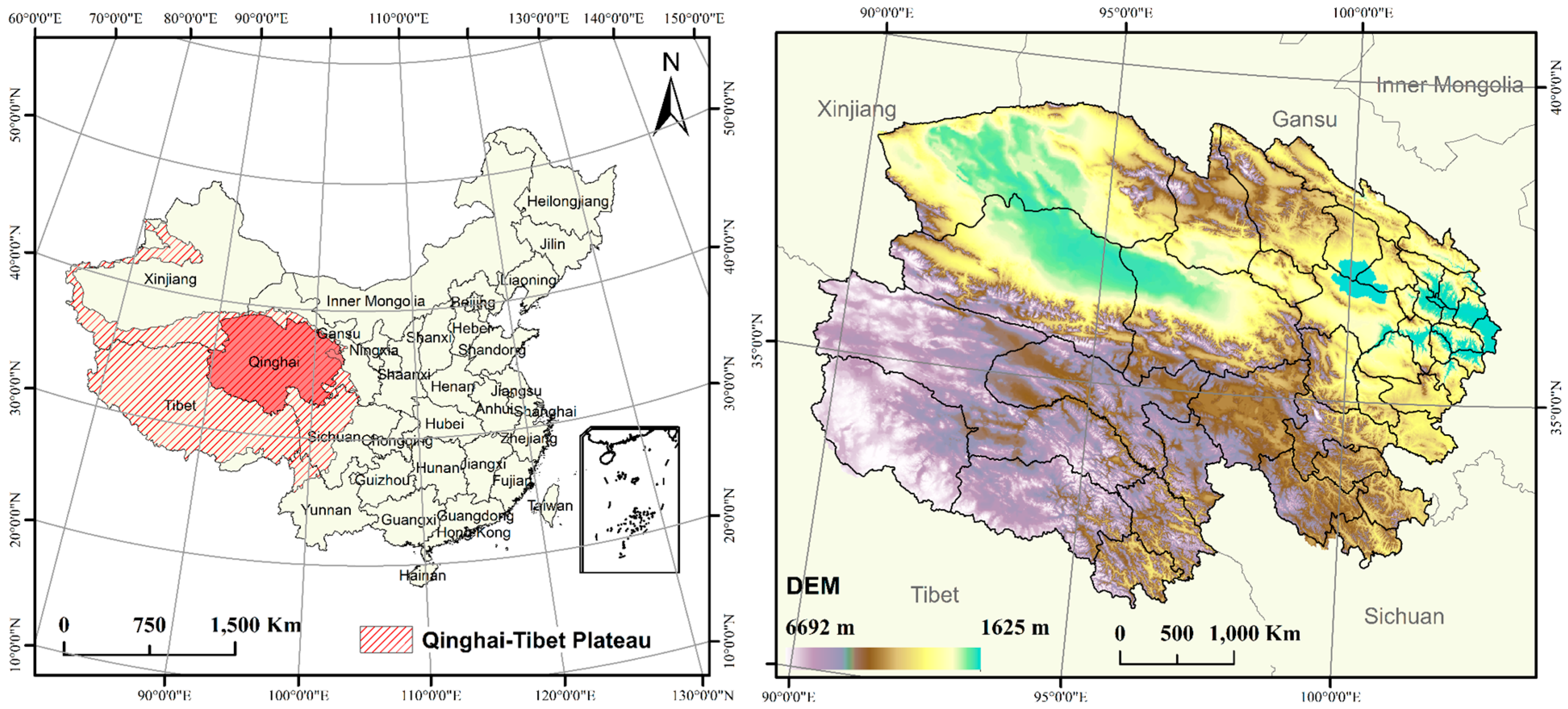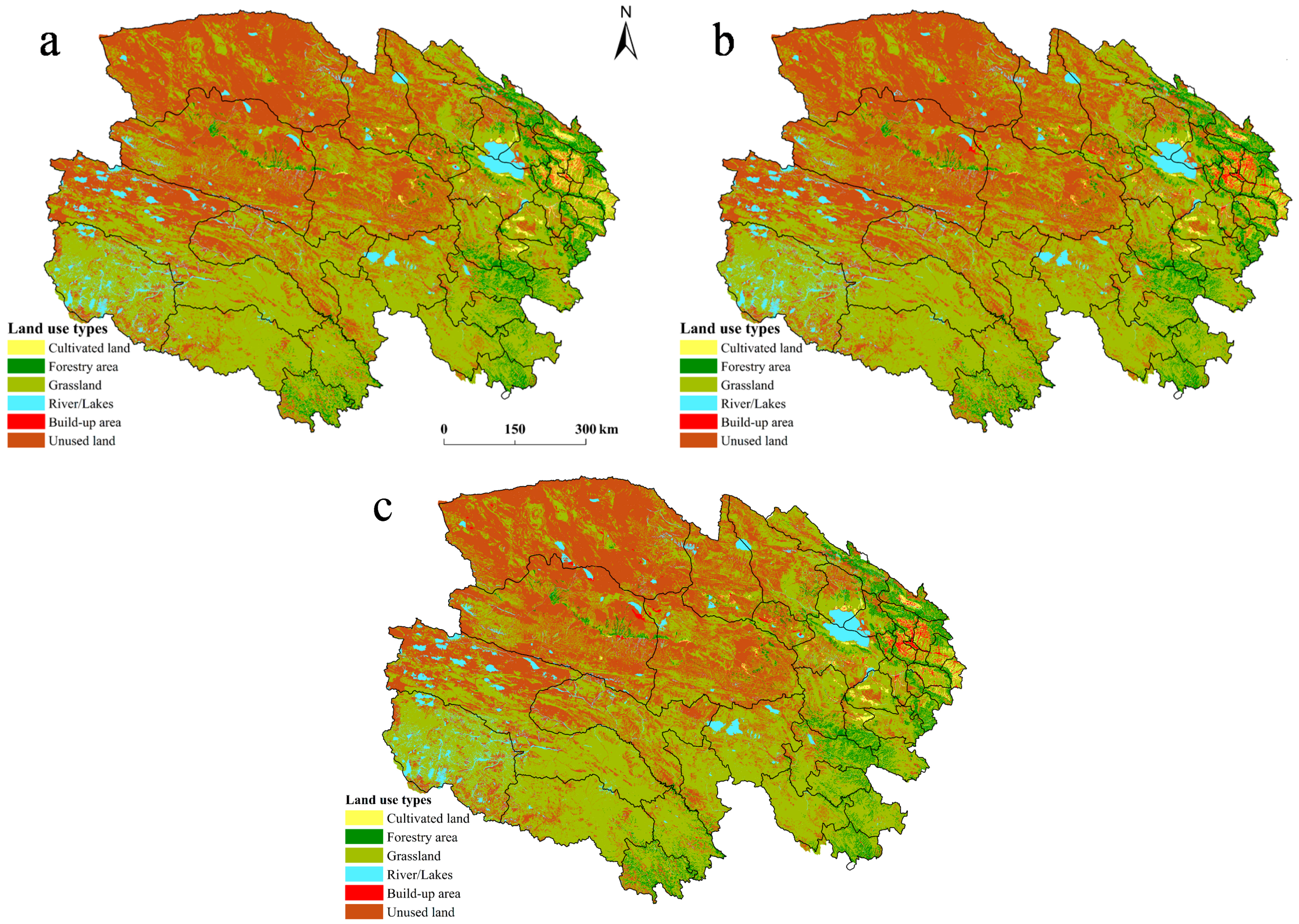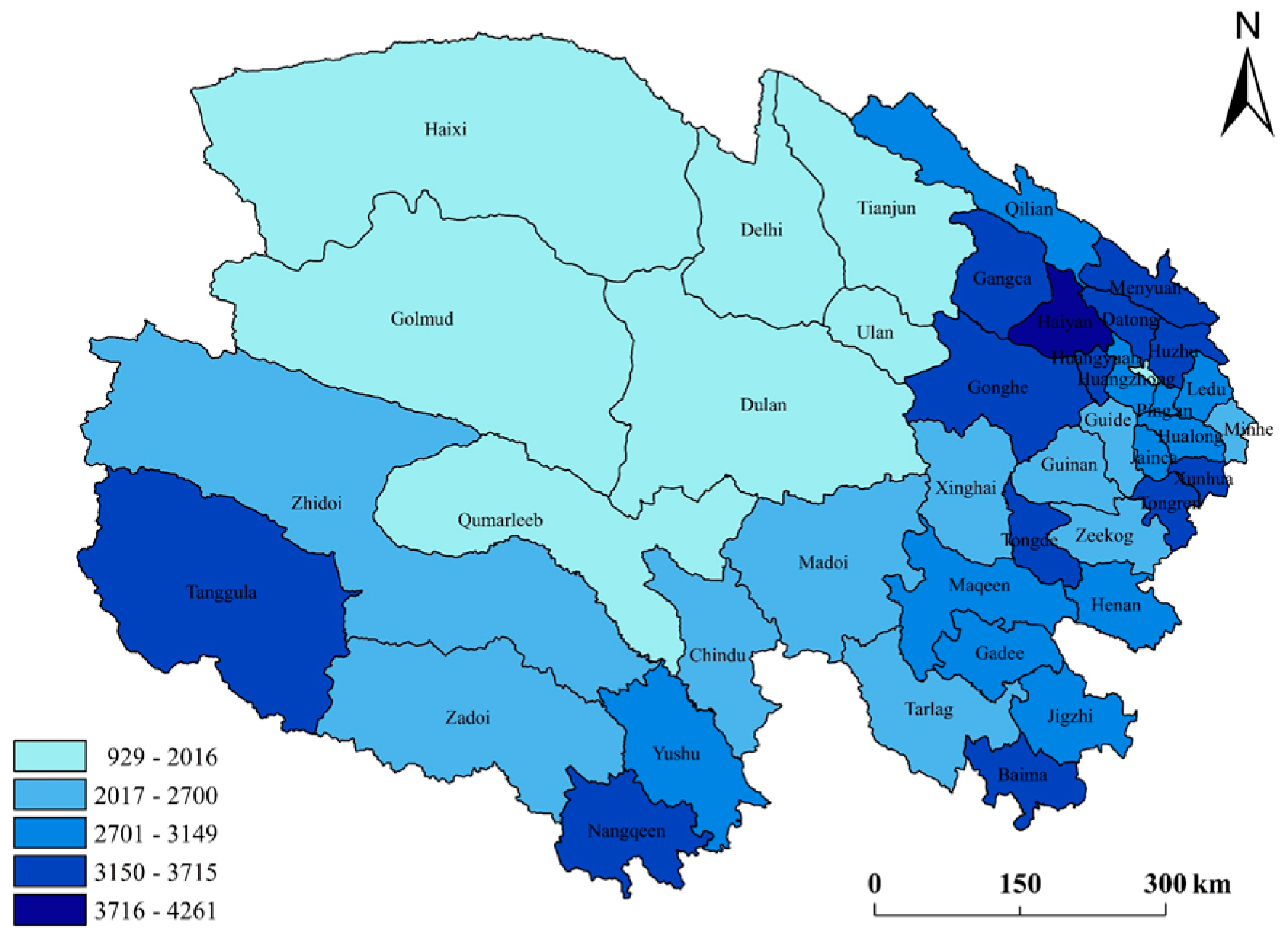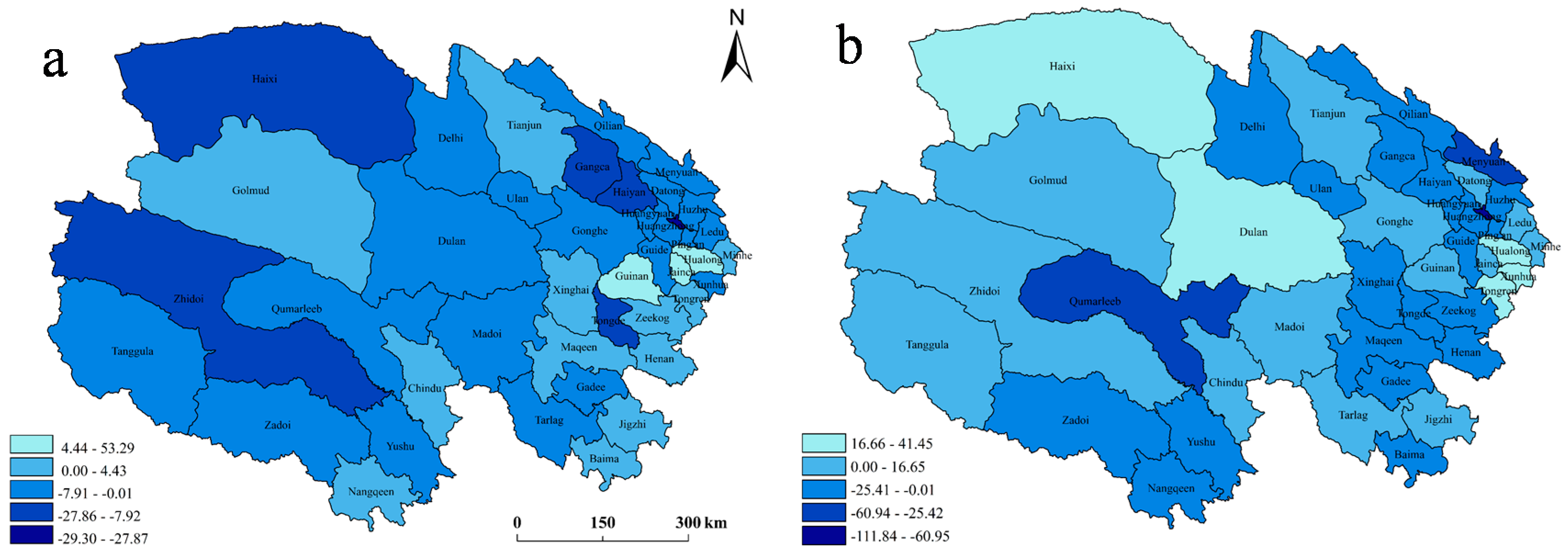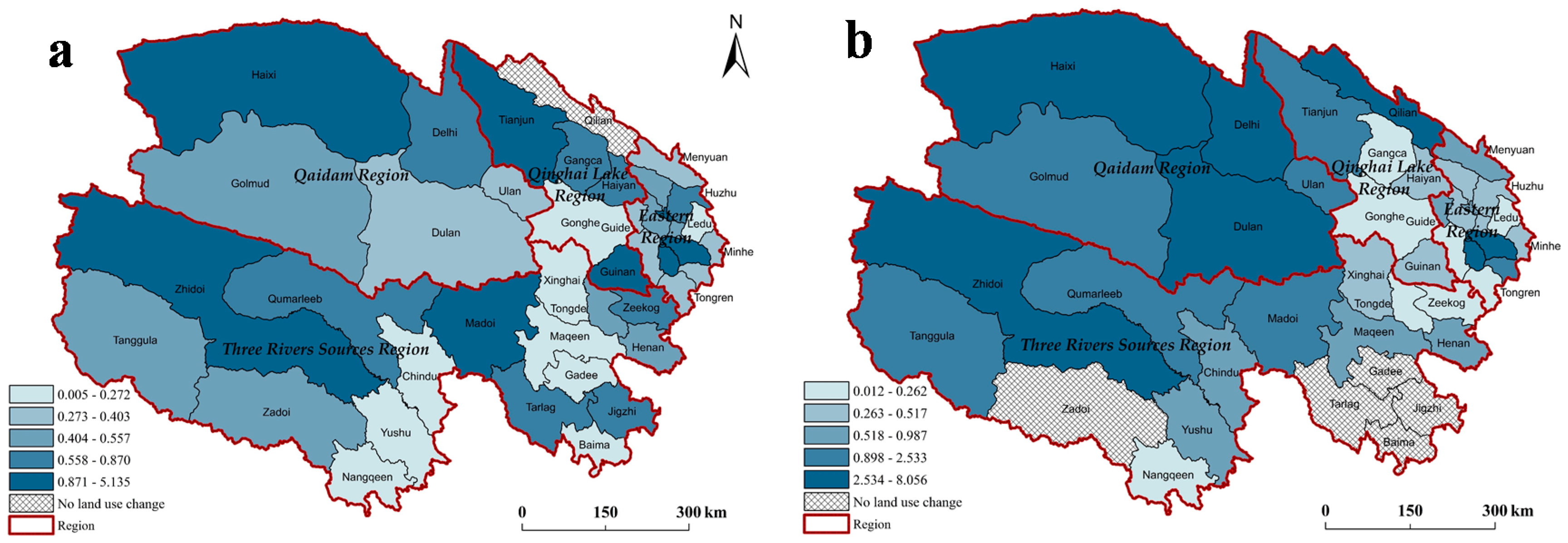1. Introduction
The terrestrial ecosystem is the area where human and natural ecosystems interact most prominently. Humans obtain most products through management of the ecological system (such as cultivation, grazing and deforestation), but alongside the increase in population, social development and growing customer demand, expanding management and ignoring the mode of operations in the ecological system will harm both its function and human welfare [
1]. Ecosystem services are the important link between the ecological system and human welfare. Knowledge of ecosystem service evolves along with the development of social economy. Carroll and Wilson [
2] called natural ecosystems “Environmental Services”, including pest control, soil formation, water and soil conservation, climate regulation and material cycles. In 1977, Westman [
3] tried to value the social benefits of natural ecosystems and called them “Nature’s Services”. In 1981, Ehrlich and Ehrlich [
4] unified the concepts of “Environmental Services” and “Nature’s Services” and put forward the term “Ecosystem Services” for the first time. In 1997, Daily [
5] and Costanza
et al. [
6] both classified ecosystem services and evaluated their economic value, which took research into ecosystem services to a new stage.
Along with gaining a deep understanding of ecosystem service, scholars have divided it according to different perspectives. Daily [
5] believed that the term “ecosystem service” refers to the conditions and processes offered by the ecological system and the species contained therein, to meet the lifestyle demands of humans. Costanza
et al. [
6] believed that ecosystem services are the benefits (like products and services) that come directly and indirectly from ecological system functions, and divided them into 17 categories. The Millennium Ecosystem Assessment (MA) and Costanza define ecosystem service in basically the same way [
7], but the former merged some of the seventeen service categories classified by Costanza and proposed four major service types: provision, regulation, support and culture.
Land is an important carrier of terrestrial ecosystems. By changing the distribution of regional resources, biodiversity and ecosystem type, land use change affects regional ecosystem service function [
8,
9,
10]. At present, studies of the ecosystem service response to land use change mainly focus on two aspects. The first focus is the change in ecosystem service value in response to the change of land structure. For example, Zhao
et al. [
11] found that from 1990 to 2000, the large scale of land rehabilitation on Chongming Island led to a decrease of 62% in the ecosystem’s service value, and 71% was due to the shrinkage of wetland and tidal flats. Lautenbach
et al. [
12] used land use data to analyze the change in ecological services from 1964 to 2004 in Leipzig, Germany. It was believed that the land consolidation of 1964–1984 was one of the important driving forces in the change of ecological services. More attention was also paid to the effects of land use change on single ecological service functions, such as biodiversity [
13], pollination [
14], animal products [
15] and soil organic carbon [
16]. Flynn
et al. [
13] indicated that the intensive use of land may not only reduce biodiversity, but also potentially imperil the provisioning of ecosystem services. Priess
et al. [
14] believed that along with the decrease of forest area, pollination ability declines continuously. This will directly reduce the yield and net income of coffee. Yadav and Malanson [
16] found that in the last 130 years, soil organic content declined constantly. It is necessary to take effective management measures to increase the organic carbon content in the soil.
Ecological sensitivity indicates the level of difficulty and potential for the occurrence of ecological environment problems in the evaluation of the disturbance of nature and human activities to the ecological system [
17]. An analysis of ecological sensitivity can help us to recognize the future possible scenario of ecological safety based on the known features of current ecological change [
18]. The research by Hendrey
et al. [
19] in the 1970s on the sensitivity of the water ecosystem to acid deposition was the earliest research on the sensitivity of an ecological system to environmental change. In 1990, scholars began to analyze climate variation, human activities and land use change as sensitivity factors affecting the ecological system. A report by the Intergovernmental Panel on Climate Change (IPCC) indicated that climate variations (e.g., air temperature, rainfall) will change the structure, composition and function of the ecosystem [
20]. The Advanced Terrestrial Ecosystem Analysis and Modelling (ATEAM) project further extended study to the sensitivity factors that affect the ecosystem (e.g., drought/flood disaster, land use change and groundwater pollution were added). Jagtap
et al. [
21] analyzed the sensitivity of seaweed growth in coastal wetland ecosystems to human activities, earthquakes and meteorological factors. Bergengren
et al. [
22] analyzed the sensitivity of land plant communities to climate change. Although sensitivity analysis has been applied in many fields, there has been little study of the sensitivity of ecological service functions to land use change. Such a sensitivity analysis has great significance in areas where the ecological environment is fragile and can give an accurate evaluation of the possibility of land use change causing eco-environmental problems.
The Qinghai-Tibet Plateau is an area including the most abundant ecosystem types in China. It is called “The Third Pole”, as the elevation of 40% of its area is above 4000 m. The Qinghai-Tibet Plateau is also the headstream of many rivers in Asia (such as the Yellow River, the Yangtze River (Jinsha River), the Lancang River (the Mekong River) and the Nujiang River (the Salween River)). It is thus called the Asian “Water Tower”. Its unique geographic and climatic characteristics have an important influence on a series of ecosystem services, such as atmospheric circulation, climate regulation, water supply and the carbon cycle in China, Asia and even the Northern Hemisphere. At the same time, the Qinghai-Tibet Plateau is also the area with the most fragile ecological system. It suffers from the multiple effects of global drying and warming [
23,
24], massif uplifts [
25,
26] and human activities (such as over-grazing, tourism development and engineering construction). As a result, many ecological deterioration phenomena have been noted, such as rising snow lines [
27], glacier recession [
28,
29,
30], loss of soil organic matter [
31,
32] and desertification [
33,
34,
35,
36,
37,
38].
Many scholars have studied the response of ecosystem service functions on the Qinghai-Tibet Plateau to land use change. For example, Xie
et al. [
39] calculated the values of different ecological assets in the Qinghai-Tibet Plateau. The results indicated that the total ecological assets account for 17.68% of China and 0.61% of the world. Lu
et al. [
40] analyzed the effect of grassland destruction in the Qinghai-Tibet Plateau on soil conservation; and also the service values of organic carbon fixation, nutrient retention and reducing soil disuse. Wang
et al. [
41] assessed the economic value of ecosystem services in the Qinghai Lake watershed from 1977 to 2004. They found that the value of ecosystem services there was declining, and the development of the economy and ecology was not in harmony. Wang
et al. [
42] studied the changed value of wetland ecosystem services in the Ihasa River basin from 1976 to 2006. It was believed that the reduction of open water area, alpine meadow and grass swamp was the main cause of the lost value of the wetland; however, most of the above studies were based on the view that land use changes can affect the value of ecological service, rather than from a perspective considering their sensitivity.
Qinghai Province is the protective ecological barrier of the northeast part of the Qinghai-Tibet Plateau. Since the Reform and Opening-up, the fast development of agricultural economy (cultivation and animal husbandry production) and urbanization has improved the local economic level, but has also destroyed the original ecological environment. Land use is the direct interaction between human and natural ecosystems. It is also an important indicator of the change in regional economy and production activity. Some scholars have investigated the effects of land use change on ecosystem service function; however, although the ecosystem of the Qinghai Province is very fragile, few studies focus on the response of local ecosystem service functions to land use change from the perspective of sensitivity. The research objectives of this paper are therefore as follows: (1) to determine the main land use changes in Qinghai Province from 1988 to 2008; (2) to estimate the response of local ecosystem service functions to the land use change in this period; and (3) to reveal the sensitivity of ecosystem service functions to land use change in Qinghai Province.
2. Study Area
Qinghai Province is in the middle-latitude zone (89°35′–103°04′ E, 31°09′–39°19′ N), and covers a vast geographic area, which includes the Qinghai-Tibet Plateau and Loess Plateau (
Figure 1). Its area is 71.75 × 10
4 km
2, one thirteenth of China’s total area. The elevation in the province ranges from 1625 m to 6692 m. The primary geomorphic type is a platform, with a proportion of 29.84%. The next most common types are high-, middle- and low-relief mountains, accounting for 22.14%, 16.06% and 13.47% of the land, respectively. With a continental plateau climate, Qinghai Province is cold, dry, windy, has less rainfall, low oxygen, a large diurnal temperature difference, long winters and short summers, four indistinct seasons and a great regional difference in climate [
43]. The annual rainfall is 250–550 mm, and rainfall concentrates in July to September. The annual average temperature is 2–9 °C, and the frost-free season lasts for 100–200 days. The annual duration of sunshine is about 2700 h. The solar radiation is strong, with the total annual radiation reaching 690.8–753.6 kJ/cm
2, and direct radiation accounts for more than 60% of total annual radiation. The annual absolute value exceeds 418.68 kJ/cm
2.
Due to the special natural and ecological conditions, socioeconomic development in Qinghai Province is relatively closed and lagging behind eastern or central China. However, in the course of 30 years after reform and opening up, the urbanization process of Qinghai Province has been speeding up. Especially after 2000, addressing the great opportunities and challenges provided by the Campaign of Developing Western China, the West-to-East Gas Pipeline Project and Qinghai-Tibet Railway, the development of the region’s economy has boosted. From the aspects of industrial structure, tertiary industries have gradually become the dominant industry in Qinghai Province, while the proportion of primary industry gradually declined.
5. Discussion
5.1. Driving Forces of Land Use Change in Qinghai Province
Both the transition of the natural environmental and social economic activities drive changes in land use, but in the short term, the effect of social economic activities is larger. Since 1988, driven by the Reform and Opening-up, Qinghai Province has exploited its superior resources to develop its industrial economy. Husbandry and the living standard of citizens have improved greatly, but at the same time, extensive resource utilization also brings ecological problems, including the sharply increasing area used as construction land and cultivated land and the decline of forestry areas, grassland and water areas to various degrees. Since 2000, along with the implementation of the Western Development Strategy, a series of engineering constructions, such as the “West-East Gas Pipeline Project” and “Qinghai-Tibet Railway”, have boosted social and economic development in Qinghai Province. During this period, the change in land use was more intense compared to the period of 1988–2000, especially the spread of construction land, with the dynamic degree increased nearly five times. Key ecological projects involving eco-environmental construction, such as returning farmland to forest or grassland, returning grazing land to grassland, the Three-North shelterbelt project, natural forest protection and the creation of nature reserves have brought positive effects in some regions. For example, the forest and grassland in the northeast of Qinghai Province (transition area of the Loess Plateau and the Qinghai-Tibet Plateau) is increasing; the unused land in the middle and west area of the Qaidam region is decreasing; and the water area is increasing; however, the forest land, grassland and water area are still declining in the Three Rivers Source region and the Qinghai Lake area. Most becomes unused land.
5.2. Main Factors Influencing Ecological Service Change in Qinghai Province
The warming and drying tendency of the climate has a negative effect on the value of ecological service in Qinghai Province, but the regulating factors in ecological service value fluctuation are human activities and land use change. Since 1988, due to the influence of the greenhouse effect (the temperature in the main pastoral regions rose 0.24–0.50 °C/10a, and the annual average increment of surface evaporation is 1.3–7.5 mm [
53]), the climate has demonstrated a tendency to warming and drying, and natural runoff decreases, which restricts the growth and development of grazing grassland. When paying attention only to production, humans over-graze grasslands, reclaim them for crop farming and even abandon cultivation of the grasslands. Consequently, the grassland area decreased by 128,400 hm
2, and the service value also decreased by 341 million yuan/a, which accounts for 0.34% of the initial value. The forest lands are scattered in the eastern area where human activities are intensive. Influenced by firewood cutting, deforestation and reclamation, the area of forest land decreased by 3500 hm
2. Its ecological service value decreased by 23 million yuan/a, accounting for 0.13% of the initial value. Forest and grassland ecosystems play a critical role in soil conservation. The shrinking of these ecosystems is the main cause of water loss and soil erosion in Qinghai Province.
The unit price of river/lake ecological service is higher, and the area fluctuation of river/lake affects the economic value greatly. From 1988 to 2000, due to the effect of climate change (such as global warming and drying, stronger surface evapotranspiration and runoff decrease), the water area decreased by 14,000 hm2. The loss of ecological service value reached 144 million yuan, but since 2000, as the water area in the middle and western area of the Qaidam region and the west high-altitude areas in the Three Rivers Source region increased (an increase of five times compared to the period of 1988–2000), the ecological service value of the water area increased by 817 million yuan. The agricultural economy in Qinghai Province has developed continually. The area of cultivated land and the ecological service value also continue to increase, but restricted by ecological projects, such as returning farmland to forest (grassland), the increasing range of the service value of cultivated land declined from 3.28% in 1988–2000 to 0.20% in 2000–2008.
5.3. Response of Ecological Service Value to Land Conversion
The direction and quantity of land use transition determines changes in ecological service value. For example, the eastern part of Qinghai Province is the region with the most intensive economic activities. In 1988–2000 and 2000–2008, its comprehensive land use dynamic was 0.05% and 0.04%, respectively, equal to or higher than the whole dynamic degree in Qinghai Province (0.02% and 0.04%), but the rate of change in ecological service value in the two periods was only 0.05% and 0.003%, which is much lower than the whole rate of change in Qinghai Province (0.11% and 0.31%). This means that the quantity of land use transition is not the only factor in ecological service value fluctuation. From the equivalent factor table (
Table 1), we see that the ecological service value per unit area can be ranked as: water area > forest > grassland > farmland > unused land. The direction of the land use transition can also therefore influence the fluctuation in ecological value.
From 1988 to 2008, the land use transition in eastern areas, affected by the development of urbanization and the husbandry economy, was mainly the transition between grassland, cultivated land and construction land. The difference in unit-area ecological service value was small, and the sensitivity was low, but in Qaidam and the Three Rivers Source region, where there is less human disturbance, the land use transition between grassland, unused land and water area dominated. These ecosystems made a great difference to unit-area ecological value, and their sensitivity was high. The sensitivity of three administrative regions (Mangya, Lenghu and Da Qaidam) in Haixi Prefecture was also higher during the two periods. This was mainly because large amounts of forest land and grassland in these regions were converted into unused land in 1988–2000, resulting in a sharp fall in ecological service value. From 2000 to 2008, however, there was a great transition from unused land to water areas in the East Taijinar and West Taijinar salt lake area, greatly increasing ecological service value.
5.4. Implications of Land Use Management According to the Sensitivity Analysis
The eco-environment of the high sensitivity regions is usually essential to human well-being and sustainable development. When the eco-environment in these regions is destroyed, it is very hard to reconstruct. Therefore, rational planning of land use and regulation of human activities will be necessary in the sensitive areas. The Three Rivers Source region whose sensitivity was relatively high and showed an increased tendency should avoid further disturbance by human activities, particularly for the large-scale construction activities. For land use management, the Three Rivers Source region should strengthen the construction of ecological engineering and implement more ecological protection planning. The Qaidam region, which has relative low ecosystem services and high sensitivity, should improve the ecosystem services by controlling the expansion of unused land (such as desertification land).
6. Conclusions
Affected by climate change and human activities, the structure and overall arrangement of land use in Qinghai Province changes constantly, and the ecological service value changes, as well. From 1988 to 2008, the land use change in Qinghai Province manifested as follows: cultivated land and construction land increased constantly; forest land and grassland decreased gradually; unused land increased first and then decreased, and the opposite happened to the water areas. In 2000–2008, urbanization and husbandry developed quickly, and land use change was more intense in 1988–2000. The eastern part of Qinghai Province and the middle and eastern part of the Qaidam Basin were the regions with the most active land use transition.
The value of ecological service in Qinghai Province was 157.368 million yuan, 157.149 million yuan and 157.726 million yuan in 1988, 2000 and 2008, respectively. The ecological service value declined first and then increased. The value of each ecosystem service can be ranked as grassland > river/lake > forest > desert > farmland. Due to the influence of the change in land utilization structure, the service value of the grassland, forest and desert ecosystem decreased by 0.34%, 0.13% and 0.03%, respectively, compared to 1988, but the service value of farmland and river/lake ecosystems increased by 3.49% and 2.34%. The change of the desert and river/lake ecosystem thus shows a certain fluctuation. Spatially, the average ecological service value decreased from the eastern and Three Rivers Source region to the Qaidam region. From 1988 to 2000, the average ecological service value in the eastern part decreased constantly, and the Three Rivers Source region and Qaidam region showed some fluctuation.
The sensitivity index reflects the response of ecological service value to land use change. In the periods 1988–2000 and 2000–2008, when the land use dynamic degree increased by 1%, the ecological service value fluctuated by 0.693% and 1.137% on average. The sensitivity of Qaidam and the Three Rivers Source region was relatively high and showed a tendency to increase, but the sensitivity in the eastern areas was the lowest, with a declining tendency.
